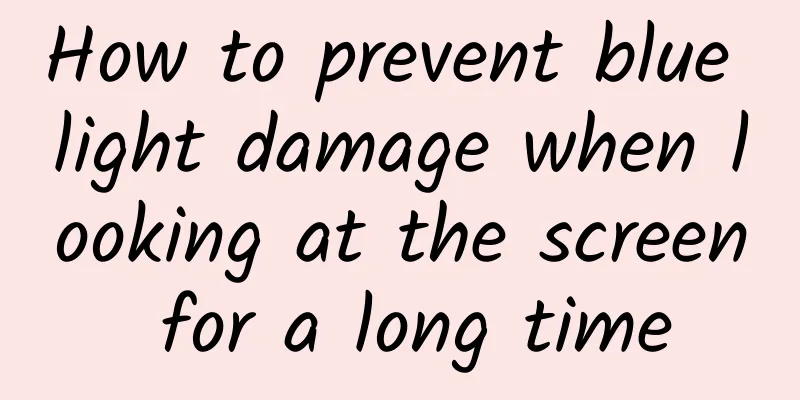How to prevent blue light damage when looking at the screen for a long time

|
Every day, whether we are working or having fun, even during the epidemic, children have to look at computers, mobile phones or other electronic screens for a long time. These electronic devices release short-wavelength, high-energy blue light, which can easily cause eye fatigue, itching, dryness, blurred vision, and even damage vision. At the 2010 International Photonics Association Annual Meeting, the world's top optical experts unanimously pointed out that short-wave blue light has extremely high energy and can penetrate the lens directly to the retina. Blue light irradiating the retina will produce free radicals, causing the retinal pigment epithelial cells to die, and then the light-sensitive cells will lack nutrients and cause vision damage, which is irreversible. Not all blue light is harmful Blue light is visible light with a wavelength range of 400 to 500 nanometers. However, considering that the wavelength range of 380 to 400 nanometers is called the blue-violet region, research on blue light usually starts from 380 nanometers. Not all blue light is harmful. The human eye has a low tolerance for blue light below 445 nanometers, but for blue light above 445 nanometers, the human eye's tolerance increases exponentially. When the energy of blue light is concentrated in the band below 445 nanometers, the light intensity exceeds a certain threshold and the retina is exposed to radiation for a long time, it is easy to cause photochemical damage to the retina, especially the blue light around 435-440 nanometers is the most harmful. In addition, blue light radiation in the 455-490 nanometer band is crucial for regulating the body's physiological rhythm. Blue light in this band can affect the secretion of melatonin in the human body, thereby affecting the body's biological clock, work efficiency, alertness, and mood. In other words, if this part of blue light is blocked on a daily basis, the regulation of the biological clock may be disrupted to a certain extent. There are many objects that emit blue light. There is blue light in sunlight. The electronic products we use in daily life, such as flat-panel TV monitors, mobile phone screens, or LED lights, incandescent lamps, fluorescent lamps, and bathroom heaters, are mostly blue-light-excited LED light sources, and the peak wavelengths are mostly between 450 and 470 nanometers. Will blue light definitely harm the human eye? This is related to the intensity and duration of exposure. When blue light exposure reaches a certain level and lasts for more than two hours, it is possible to cause damage to the retina. Since the wavelength of blue light is short, the focal point does not fall on the center of the retina, but a little closer to the retina. In order to see clearly, the eyeball will be in a tense state for a long time, causing visual fatigue. Long-term visual fatigue may worsen myopia and cause symptoms such as double vision, serial reading, and inability to concentrate, affecting learning and work efficiency. The death of retinal epithelial cells caused by blue light is irreversible and will eventually lead to an incurable disease - macular degeneration. The vision of the human eye mainly depends on the macula. If the macular degeneration is serious, there is a risk of blindness. Blue light accelerates aging and shortens lifespan In addition to the retina, blue light can also harm other parts of the body. The latest US research found that blue light released by LEDs not only affects sleep quality, but is also likely to permanently damage retinal cells and accelerate aging. The researchers used fruit flies, whose cell mechanisms are similar to those of humans, to conduct experiments and divided the flies into three groups: one group was in a completely dark environment, one group was exposed to blue light from mobile phones and computer LEDs for 12 hours a day, simulating the light that humans receive from them, and the other group used filters to filter out the blue light. The results showed that the median lifespan of fruit flies exposed to 12 hours of blue light was reduced by 42% compared to fruit flies living in complete darkness, which means that their lifespan was only half that of the other group of fruit flies. In order to confirm the reason for the shortened lifespan, the researchers asked fruit flies to practice climbing walls. The results showed that the ability to climb walls also decreased. Further brain slices were also found to have a relatively empty head when the fruit flies were exposed to blue light. This can prove that the reduction in lifespan is caused by rapid aging. The research team said that in the group of fruit flies that filtered out blue light, the median lifespan increased by 10% compared with the blue light group, and the wall climbing ability did not decrease significantly, which can indirectly prove that blue light is the cause of rapid aging. How to prevent blue light damage Wei Wenbin, director of the Department of Ophthalmology at Beijing Tongren Hospital, once said that only long-term, high-intensity, uninterrupted exposure to short-wavelength blue light will have an impact on eye health. If you look at the screen for a short time and can take a break from looking at it to rest your eyes properly, you don't need to wear blue light blocking glasses. If you look at the screen frequently and continuously, and consider the medium- and long-term cumulative effects, you can wear blue light blocking glasses. Good blue light blocking glasses can protect the eyes and allow blue light that regulates physiological rhythms to enter the human eye normally. Generally, blue light blocking glasses are mainly divided into two types of lenses: coated or tinted. Tinted lenses directly absorb blue light and can block 60% to 70% of blue light depending on the depth of tinting; coated lenses are transparent in appearance and block blue light by reflection, which can block about 10% to 12% of blue light. Blue light lenses are available in four base colors: red, yellow, green, and orange, with light yellow and light green being more popular. Patients with macular degeneration or who have undergone fundus surgery will benefit from wearing tinted lenses. Tips for protecting your eyes Computer screen: Place it 50-66 cm away from your eyes and slightly below eye level. Regularly remove dust and fingerprints from the screen surface. Because smudges will reduce the contrast of the screen and cause problems such as glare and reflection. Don’t use mobile phones and other electronic products for too long: When using it, it is recommended to download an application that filters blue light. Work Environment: Change lighting to eliminate glare and harsh reflections. Use an adjustable chair. Work habits: Try the 20-20-20 rule: For every 20 minutes of screen time, look away 20 feet for 20 seconds. Eye care routine: Close your eyes and place a washcloth soaked in warm water over them. If your eyes feel dry, apply one or two drops of artificial tears to moisten them. If your eyes dry out when you're indoors, use an air filter to filter out dust and a humidifier to add moisture to the air. If you experience eye fatigue or pain, see your eye doctor and schedule an appointment for a full eye exam. Lutein intake from food: Lutein accumulates in the macula of the fundus. Before blue light reaches the sensitive cells on the retina, it will first pass through the highest concentration of lutein. At this time, if the macula is rich in lutein, this damage can be minimized. Lutein can be said to be the only line of defense for the fundus against blue light. People need to supplement lutein for the fundus through food. For example, corn, yellow-green vegetables, fruits, etc. all contain lutein. But for modern people, the lutein obtained from food cannot meet the normal needs of the human body. Lutein products need to be supplemented to obtain the required lutein and protect the eyes from the damage of blue light from the screen. In addition to being able to deal with daily blue light damage, lutein can also be used for the prevention and postoperative rehabilitation of cataracts, the treatment and prevention of retinopathy, macular degeneration, and the prevention of high myopia, visual fatigue, night blindness and other eye diseases. Still staring at your phone? Give your eyes a break now! Protect your eyesight, prevent myopia, start doing eye exercises! |
<<: Share: How does technology change life? - Data Infographic
>>: How to spend the 100 days after a bone injury surgery
Recommend
Brown stuff in vaginal discharge
Leucorrhea is a substance secreted from the femal...
What causes acute pelvic inflammatory disease?
There are many causes of acute pelvic inflammator...
There is a strange smell down there during the confinement period
There is a strange smell down there during the co...
Six weeks pregnant with abdominal pain
About six weeks of pregnancy, which is one and a ...
Does a woman's vagina get bigger after giving birth?
Many women feel that their vagina becomes larger ...
What is the cause of bleeding on non-menstrual holidays?
We all know about menstrual bleeding, but girls h...
How to maintain after ectopic pregnancy surgery
I believe everyone is familiar with the disease o...
What foods can relieve labor pain?
The labor pains before delivery make many expecta...
Will a pelvic mass cause infertility?
Don't think that the pelvic cavity will not d...
What are the symptoms of cervical erosion changing from severe to moderate?
Cervical erosion is a common gynecological diseas...
Is it normal to have your period 9 days early?
Early menstruation is actually a sign of physical...
How to treat eczema during pregnancy?
In our daily life, many pregnant mothers are very...
Gynecologists explain: What is normal leucorrhea like?
Leucorrhea is the basis of women's health, an...









